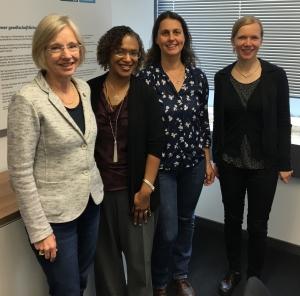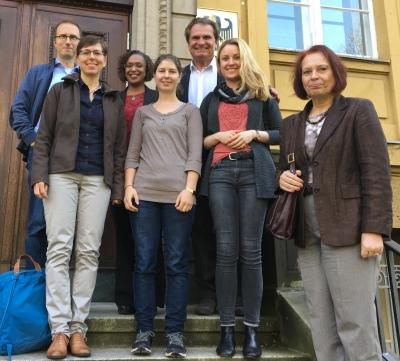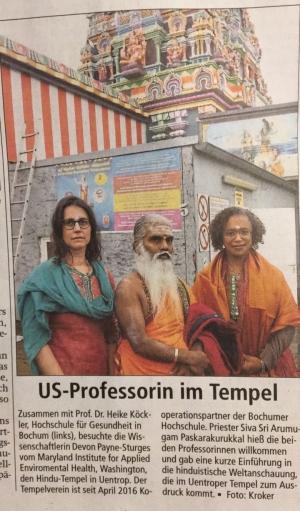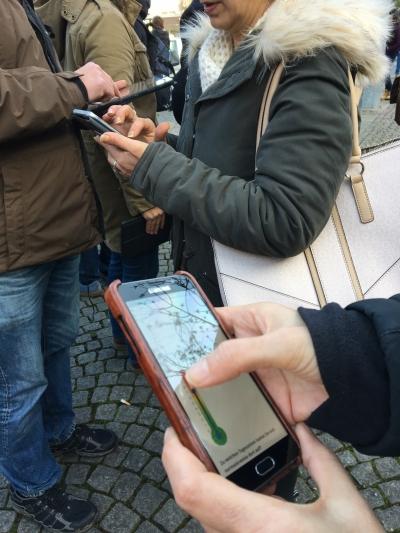

Applied Environmental Health Assistant Professor Devon Payne-Sturges spent the month of October, 2017, at the Hochschule für Gesundheit, Department of Community Health, at the University of Applied Sciences in Bochum, Germany as a Fulbright Senior Specialist. Her research has focused on environmental justice and cumulative exposures to multiple chemicals. Dr. Payne-Sturges shared this narrative of her experiences in Germany.
People may not think of Germany as a place to study social disparities in environmental health or environmental justice. However, based on my experience this past fall as a Fulbright Specialist at the Hochschule für Gesundheit (HSG) - University of Applied Sciences, Germany turns out to be a compelling setting to pursue these topics and conduct comparative analyses. Environmental Justice (EJ) in Germany is gaining more and more attention, although mainly among academics and policy makers. According to a 2015 UN report, Germany is host to the second-highest number of international migrants worldwide, behind the US, which presents opportunities to conduct research on questions of social justice and improving health. Faculty at my host institution HSG are accomplished researchers in urban planning, environmental justice, health economics, the role of culture in health and diversity in health. Ongoing research collaborations include migrant health in the segregated district of Hustadt in Bochum, disparities in community noise, urban planning, characterizing environmental health disparities using indicators and mapping, and a health and culture partnership with Sri Kamadchi Ampal Temple in Hamm, the largest Hindu temple in central Europe.

I was awarded a Fulbright Specialist grant to advise and assist faculty in the Department of Community Health at HSG in developing course topics and scenarios for digital participatory place analysis on health and analyzing results in the context of cumulative risk assessment and environmental justice for their new “DiPS-Lab” (in German: DiPS stands for “Digitale Methoden partizipativer Sozialraumanalyse”). In addition to curricula development, I conducted comparative research on social conceptualization and policy development on cumulative risk in Germany. To fulfill these objectives I engaged in a number of information exchange activities. I gave an invited lecture to scientists at the German Environment Agency (Umweltbundesamt) in Berlin (see photo at left) and participated in individual meetings with scientists involved in human biomonitoring, urban planning, environmental justice and global burden of disease reporting. I visited key sites in Berlin where specific urban planning projects have been implemented to address social disparities and environmental burdens.

At HSG I participated in two DiPS lab activities: demonstration of an interactive map-table application with clients of the Wewole Foundation in Herne, which supports individuals with intellectual and physical disabilities; and pilot testing of a community noise survey app with HSG students in the Place and Health course of study. I co-hosted with Dr. Köckler a small international workshop among academic researchers on the topic of cumulative risk and environmental justice. We examined how these issues are addressed in the U.S., Germany and the Netherlands.
As a result, a number of collaborative research ideas were identified that we will pursue. I was then invited to visit the University of Bremen to continue discussion of research ideas, provide advice on development of environmental health indicators, and to meet with students in the epidemiology program. Lastly, I designed and directed a lecture and discussion activity at my host institution on the role of place and health. I drew from materials I have used in my own courses at the University of Maryland. This lecture was open to students and community partners. As a result, the head priest of the Sri Kamadchi Ampal Temple attended, and this led to an invitation by the priest for me to visit to the temple. This was definitely a highlight of my stay in Germany. My visit was even covered in the local newspaper! (See clipping at left)
Based on these activities, Dr. Köckler and I drafted course materials and exercises she can use to explore role of place in promoting health that combines screening and discussion of the U.S. documentary Unnatural Causes. We used available databases to assess neighborhood health and environmental conditions, and developed an approach to mapping multiple burdens at the neighborhood level using the capabilities of the DiPS lab.

In addition, we plan to use the DiPS-Noise app in an American setting through my undergraduate course, Introduction to Environmental Health, during Spring semester. (The photo at left shows HSG Students using DiPS-Larm noise survey app in the Wattenscheid community.) We plan to convene our students (UMD students and the HSG students) via a video call so they can share their experience and observations about the DiPS-Noise community survey app. This will enrich the learning of all our students.
There are several important outcomes of my Fulbright project. I gained better understanding of the conceptualization of cumulative risk and environmental justice in Germany. It seems the preferred terminology here is “multiple burdens,” which may be more easily understood by the public. I participated in demonstration of the digital participatory place analysis or DiPS, which is a useful approach that I plan to use in my teaching and my research.
Lastly, I gained insights into the tensions that arise as researchers transition from describing social disparities in environmental health to identifying underlying causes for those disparities in the German context. EJ and health disparities are almost exclusively observed as a spatial distribution issue. In fact EJ in Germany is defined as “addressing the uneven [spatial] distribution of exposure to environmental pressures and environmental resources and its health implications, with the aim of helping to create healthy environmental and living conditions.” Researchers and policy makers tend to avoid terms like race, ethnicity, racism or discrimination to explain differences. From my discussion it seems that the experience of WW II has created these taboos. In fact even the German word for justice, “gerechtigkeit” generates strong emotional meaning that policy makers would like to eschew. The phrase “social aspects of environmental policy” may be more preferred. However, there is a benefit to the focus on EJ as a spatial concept.
In Germany there appears to be closer linkages between environmental protection and urban development and more opportunity to foster intersectoral planning and action on transportation, noise, green space and “bio-climate.” Mapping of multiple environmental burdens is regularly used to target areas for local and state urban development program funding (i.e. the German Sozialen Stadt or “Social City” program ) to address disparities. This approach could serve as model for the US and elsewhere.
Related Links: